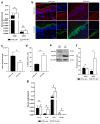Ex Vivo Analysis of Cell Differentiation, Oxidative Stress, Inflammation, and DNA Damage on Cutaneous Field Cancerization
- PMID: 38891963
- PMCID: PMC11171589
- DOI: 10.3390/ijms25115775
Ex Vivo Analysis of Cell Differentiation, Oxidative Stress, Inflammation, and DNA Damage on Cutaneous Field Cancerization
Abstract
Cutaneous field cancerization (CFC) refers to a skin region containing mutated cells' clones, predominantly arising from chronic exposure to ultraviolet radiation (UVR), which exhibits an elevated risk of developing precancerous and neoplastic lesions. Despite extensive research, many molecular aspects of CFC still need to be better understood. In this study, we conducted ex vivo assessment of cell differentiation, oxidative stress, inflammation, and DNA damage in CFC samples. We collected perilesional skin from 41 patients with skin cancer and non-photoexposed skin from 25 healthy control individuals. These biopsies were either paraffin-embedded for indirect immunofluorescence and immunohistochemistry stain or processed for proteins and mRNA extraction from the epidermidis. Our findings indicate a downregulation of p53 expression and an upregulation of Ki67 and p16 in CFC tissues. Additionally, there were alterations in keratinocyte differentiation markers, disrupted cell differentiation, increased expression of iNOS and proinflammatory cytokines IL-6 and IL-8, along with evidence of oxidative DNA damage. Collectively, our results suggest that despite its outwardly normal appearance, CFC tissue shows early signs of DNA damage, an active inflammatory state, oxidative stress, abnormal cell proliferation and differentiation.
Keywords: DNA damage; field cancerization; oxidative stress; skin cancer; ultraviolet light.
Conflict of interest statement
The authors declare no conflicts of interest.
Figures





Similar articles
-
[ASSOCIATION OF SKIN PHOTOTYPE AND UV EXPOSURE WITH EXPRESSION OF HER RECEPTORS, Ki67 AND p53 IN PATIENTS WITH CUTANEOUS SQUAMOUS CELL CARCINOMA].Acta Med Croatica. 2015;69(5):431-8. Acta Med Croatica. 2015. PMID: 29087088 Croatian.
-
P53, p16 and Ki67 immunoexpression in cutaneous squamous cell carcinoma and its precursor lesions.Rom J Morphol Embryol. 2016;57(2 Suppl):691-696. Rom J Morphol Embryol. 2016. PMID: 27833960
-
UV-Induced Molecular Signaling Differences in Melanoma and Non-melanoma Skin Cancer.Adv Exp Med Biol. 2017;996:27-40. doi: 10.1007/978-3-319-56017-5_3. Adv Exp Med Biol. 2017. PMID: 29124688 Review.
-
Selenium deficiency sensitizes the skin for UVB-induced oxidative damage and inflammation which involved the activation of p38 MAPK signaling.Food Chem Toxicol. 2015 Jan;75:139-45. doi: 10.1016/j.fct.2014.11.017. Epub 2014 Nov 25. Food Chem Toxicol. 2015. PMID: 25460360
-
Ultraviolet radiation effects on the proteome of skin cells.Adv Exp Med Biol. 2013;990:111-9. doi: 10.1007/978-94-007-5896-4_8. Adv Exp Med Biol. 2013. PMID: 23378007 Review.
Cited by
-
Comparison of routine blood parameters by altitude and residence duration in the Western Sichuan Plateau.Pract Lab Med. 2025 Mar 19;45:e00467. doi: 10.1016/j.plabm.2025.e00467. eCollection 2025 Jul. Pract Lab Med. 2025. PMID: 40242487 Free PMC article.
References
-
- Braakhuis B.J.M., Tabor M.P., Kummer J.A., Leemans C.R., Brakenhoff R.H. A Genetic Explanation of Slaughter’s Concept of Field Cancerization: Evidence and Clinical Implications. Cancer Res. 2003;63:1727–1730. - PubMed
MeSH terms
Substances
LinkOut - more resources
Full Text Sources
Medical
Research Materials
Miscellaneous

